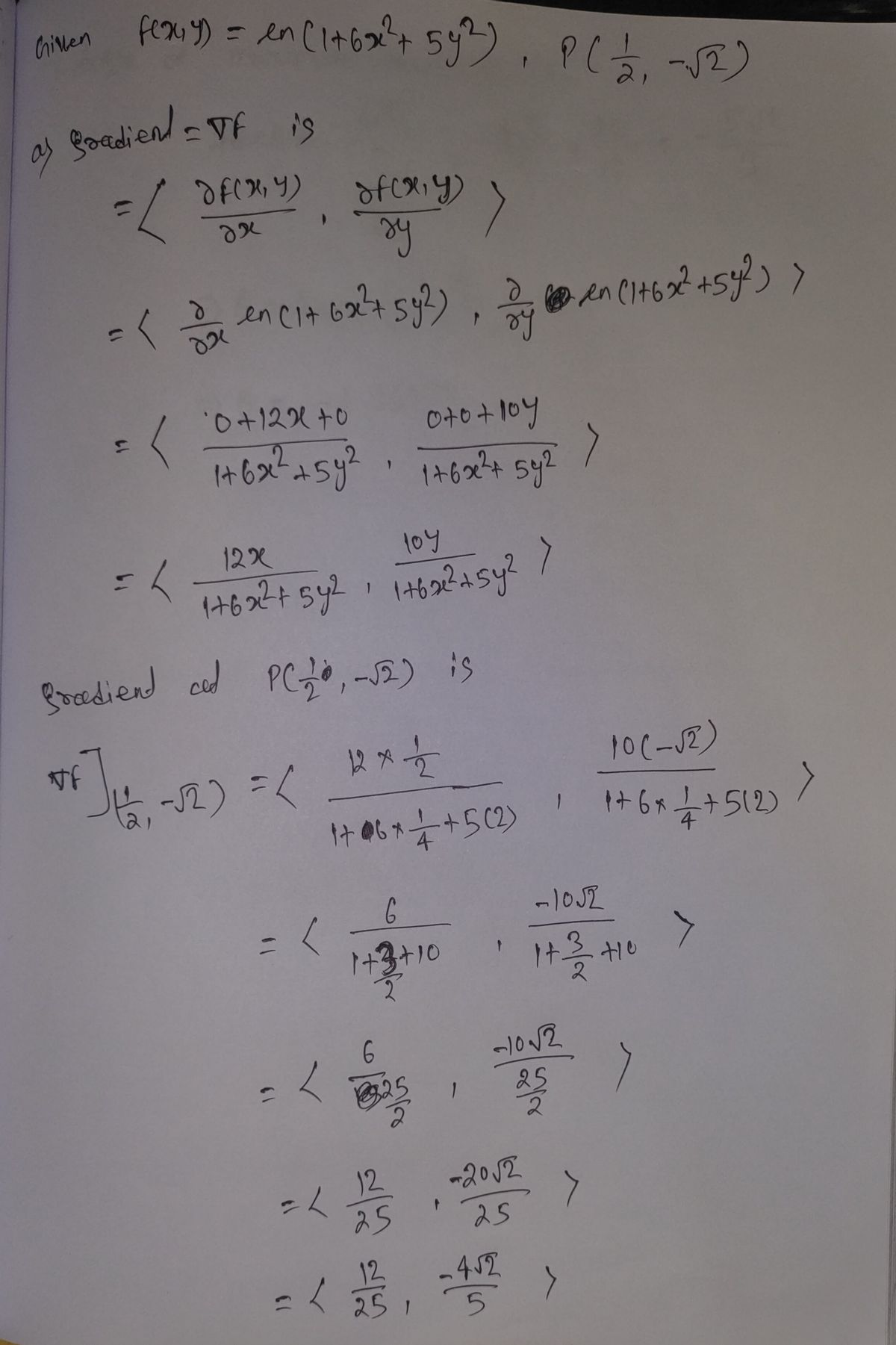A function f and a point P are given. Let 9 correspond to the direction of the directional derivative. Complete parts a. through e. 1. P(1/1₁ -√²) f(x,y)=In (1 +6x² +5y²), P a. Find the gradient and evaluate it at P. 4√2 The gradient at P is 12 b. Find the angles (with respect to the positive x-axis) between 0 and 2x associated with the directions of maximum increase, maximum decrease, and zero change. What angles are associated with the direction of maximum increase? (Type your answer in radians. Type an exact answer terms of Use a comma to separate answers as needed.)
A function f and a point P are given. Let 9 correspond to the direction of the directional derivative. Complete parts a. through e. 1. P(1/1₁ -√²) f(x,y)=In (1 +6x² +5y²), P a. Find the gradient and evaluate it at P. 4√2 The gradient at P is 12 b. Find the angles (with respect to the positive x-axis) between 0 and 2x associated with the directions of maximum increase, maximum decrease, and zero change. What angles are associated with the direction of maximum increase? (Type your answer in radians. Type an exact answer terms of Use a comma to separate answers as needed.)
Advanced Engineering Mathematics
10th Edition
ISBN:9780470458365
Author:Erwin Kreyszig
Publisher:Erwin Kreyszig
Chapter2: Second-order Linear Odes
Section: Chapter Questions
Problem 1RQ
Related questions
Question
![**Gradient and Directional Derivative Analysis**
A function \( f \) and a point \( P \) are given. Let \( \theta \) correspond to the direction of the directional derivative. Complete parts a. through e.
\[ f(x, y) = \ln \left(1 + 6x^2 + 5y^2\right) , \quad P \left( \frac{1}{2}, -\sqrt{2} \right) \]
**a. Find the gradient and evaluate it at \( P \).**
The gradient at \( P \) is
\[
\left( \frac{12}{25}, -\frac{4\sqrt{2}}{5} \right) .
\]
**b. Find the angles \( \theta \) (with respect to the positive x-axis) between \( 0 \) and \( 2\pi \) associated with the directions of maximum increase, maximum decrease, and zero change. What angles are associated with the direction of maximum increase?**
**Answer in Radians:**
Type your answer in radians. Type an exact answer in terms of \(\pi\). Use a comma to separate answers as needed.
**Note:**
This section involves finding angles that relate to the change in direction of the function. The maximum increase is in the direction of the gradient vector.](/v2/_next/image?url=https%3A%2F%2Fcontent.bartleby.com%2Fqna-images%2Fquestion%2F511d779c-bf10-4315-98b1-4f0038c55113%2F6c347548-ae24-4d16-8d7f-e6d7debd10a0%2Fchgq8dh_processed.png&w=3840&q=75)
Transcribed Image Text:**Gradient and Directional Derivative Analysis**
A function \( f \) and a point \( P \) are given. Let \( \theta \) correspond to the direction of the directional derivative. Complete parts a. through e.
\[ f(x, y) = \ln \left(1 + 6x^2 + 5y^2\right) , \quad P \left( \frac{1}{2}, -\sqrt{2} \right) \]
**a. Find the gradient and evaluate it at \( P \).**
The gradient at \( P \) is
\[
\left( \frac{12}{25}, -\frac{4\sqrt{2}}{5} \right) .
\]
**b. Find the angles \( \theta \) (with respect to the positive x-axis) between \( 0 \) and \( 2\pi \) associated with the directions of maximum increase, maximum decrease, and zero change. What angles are associated with the direction of maximum increase?**
**Answer in Radians:**
Type your answer in radians. Type an exact answer in terms of \(\pi\). Use a comma to separate answers as needed.
**Note:**
This section involves finding angles that relate to the change in direction of the function. The maximum increase is in the direction of the gradient vector.
Expert Solution
Step 1

Step by step
Solved in 2 steps with 2 images

Recommended textbooks for you

Advanced Engineering Mathematics
Advanced Math
ISBN:
9780470458365
Author:
Erwin Kreyszig
Publisher:
Wiley, John & Sons, Incorporated

Numerical Methods for Engineers
Advanced Math
ISBN:
9780073397924
Author:
Steven C. Chapra Dr., Raymond P. Canale
Publisher:
McGraw-Hill Education

Introductory Mathematics for Engineering Applicat…
Advanced Math
ISBN:
9781118141809
Author:
Nathan Klingbeil
Publisher:
WILEY

Advanced Engineering Mathematics
Advanced Math
ISBN:
9780470458365
Author:
Erwin Kreyszig
Publisher:
Wiley, John & Sons, Incorporated

Numerical Methods for Engineers
Advanced Math
ISBN:
9780073397924
Author:
Steven C. Chapra Dr., Raymond P. Canale
Publisher:
McGraw-Hill Education

Introductory Mathematics for Engineering Applicat…
Advanced Math
ISBN:
9781118141809
Author:
Nathan Klingbeil
Publisher:
WILEY

Mathematics For Machine Technology
Advanced Math
ISBN:
9781337798310
Author:
Peterson, John.
Publisher:
Cengage Learning,

